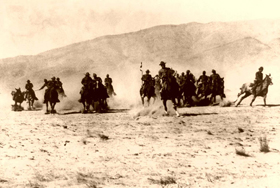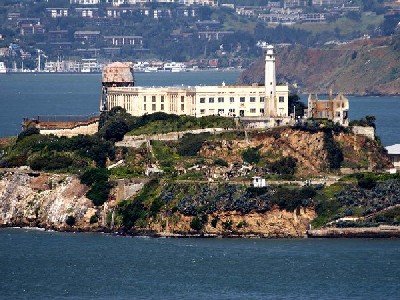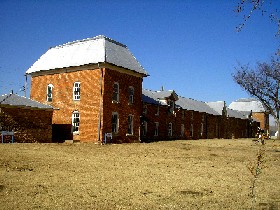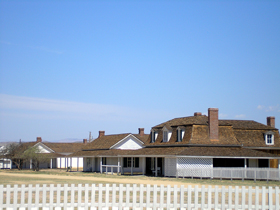The forts of the American West varied in type from military posts, to fortresses established by fur trading companies, to private enterprises built solely to protect the pioneers within.
Most often when we think of Old West forts, we imagine a high stockade type wall of sharpened logs that surround a number of buildings. Inside these walls are hardy pioneers and soldiers, valiantly defending themselves from hostile Indians on the outside. Though western films have perpetuated this idea, and sometimesforts were built in a stockade type manner, the purpose and style offorts varied widely and this "typical" scenario was the exception rather than the rule.
Contrary to the myths perpetuated by western films, most militaryforts of the American West were not established to protect the settlers from Indians; rather, they were built to maintain peaceamong the tribes, as well as between Native Americans and white emigrants.
| Many people are not aware that Alcatraz was a fort before it became a Penitentiary. Photo by John Sullivan, March, 2005. This image available for photographic prints |
 Furthermore, they were seldom solidly constructed stockades with numerous permanent buildings. Sometimes, they were little more than a couple of blockhouses. Other types of fortifications were constructed by traders to protect their businesses and by settlers to protect their homes. Furthermore, they were seldom solidly constructed stockades with numerous permanent buildings. Sometimes, they were little more than a couple of blockhouses. Other types of fortifications were constructed by traders to protect their businesses and by settlers to protect their homes.As more and more settlers moved west in the 19th century Army posts were established on the basis of anticipated use, sometimes to keep the Indian tribes from waging war with each other and at other times, to keep white settlers from encroaching upon native lands. It was generally only when white settlers insisted on encroaching upon native lands, especially during the many gold and silver rushes, that the Indians retaliated. Only then did the forts’ primary purpose change to protecting the settlers. As westward expansion continued, threatening the Indian's livelihood, war between the whites and Indiansintensified, resulting in the push of Native Americans onto reservations. Once the Indianswere placed on reservations, some forts served as Indian agencies and distribution points for annuities given to tribes under treaty agreements. When the many trails began to open such, as the Santa Fe Trail in the 1820’s and theOregon Trail in the 1840’s, traders and pioneers often met with not only, opposition from the tribes, but also, by road agents interested in relieving them of their money or their goods. In response, more forts were established to protect commerce along the trails. When establishing a new fort, the soldiers would sometimes occupy buildings already established, but more often, were required to construct the new fort from materials available in the area. In forested areas, wood was usually used; adobe in the desert, and stone, where available. The typical frontier fort consisted of officers' quarters, barracks, stables, storehouses, and headquarters buildings, grouped around a central parade ground. Mostforts did not have walls surrounding them because attacks were generally unlikely. Many army posts were referred to as "camps,” when there were only a few people assigned to the location or when the site was temporary. To be considered a "fort,” a full contingent of troops had to be permanently assigned to it. Both forts and camps were utilized by the U.S. Army during the Frontier Campaigns.
2005, Kathy Weiser. This image available for photographic prints and
| Reacting to the quickly changing needs of the vast west, the Army would set up a post and then abandon it when no longer needed. Though it was not the original intent to establish militaryforts to fight the Indian Wars, this changed when the U.S. government failed to protect tribal territorial rights and uphold treaties. Increasingly upset with treaty violations and travelers, settlers, and railroad crews encroaching on their lands, the Indians were retaliating in full force by the mid-1800s. As a result the U.S. Government began a series of frontier campaigns to "tame” the Indians, force them on to reservations, and convert them to "civilized” life.
For the soldier, life was difficult and often monotonous at these many frontier outposts. The vast majority of recruits saw little or no combat and spent their time doing manual labor. Many forts were so isolated there were no nearby towns for single enlisted men to relieve the monotony or meet women. The normal "dull existence” of frontier life was too much for many of the troops and desertion rates were high.
|
Today, many of these Old West forts have been preserved, restored or rebuilt as monuments to our heritage and can still be seen as museums and national or state parks.
Also See:
|
|
|
|





This program is for everyone. It is for the poor, the lazy, the lame, those who work it, those who do not work it. It is for the least of them, it is for those who cannot help themselves. It is for the net-workers and those who are not net-workers. It is even for those who are totally ignorant of how to earn money using the Internet.
ReplyDeletehttp://world-wealth4allteam.blogspot.com